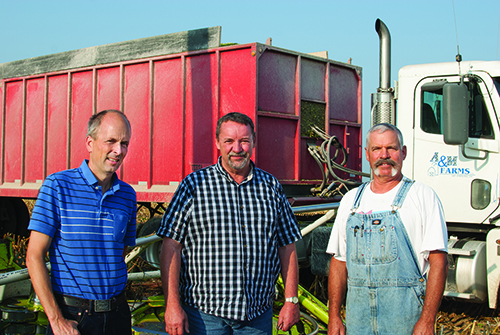
By incorporating a blend of homegrown forages and those raised by Gene Baumgardner, Teun Verhoeven fills the bunkers for his 1,400-cow dairy. On his South Solon, Ohio, farm, Verhoeven grows 500 acres of corn for silage along with 200 acres of alfalfa. He supplements that with an additional 800 acres from Baumgardner, who crops a total of 2,000 acres.
"It's the most crucial decision of the year," said Verhoeven in response to our question: When do you harvest forages?
"With the corn silage, we try to chop as much as possible at once so we don't have to close and open the pile again. However, we haven't been able to completely avoid that situation, as corn planted on land without double-cropping is always a couple of weeks earlier," said Verhoeven.
"This is a disadvantage, but it also spreads the harvest out a little. In a dry year we can still get it all made at the right dry matter. We like to harvest no wetter than 32 to 33 percent dry matter and no drier than 39 to 40 percent dry matter," he went on to say.
Verhoeven has been dairying in Ohio for 13 years and placed a high importance on finding a qualified cropping partner. To ensure equitable pricing on both sides, the duo weighs every load of feed on scales and routinely conducts bushel tests to give an indication of starch and energy levels.
Baumgardner, who runs Rickets Farms, and Verhoeven routinely meet to ensure both parties are satisfied with the cropping arrangement. "I'm looking for the most milk per ton of forage, while Gene is looking at yield and profit per acre. We need to be in sync and meet in the middle," said Verhoeven. "During winter, we sit down and talk in more detail on what went well and what needs improvement," he said. Shown above are (L to R): Verhoeven; Artie Dick, chopper; and Baumgardner.
The Twin Oaks and Rickets Farm partnership also had this to say in response to additional questions focused on "What drives their crops and forages":
How are forage and tillage operations handled on your farm?
Most of the work is done by our partner Gene Baumgardner, who does a majority of the tillage and planting, and Dave Shannon and Artie Dick, who do most of the harvesting. We have a grain drill for the small grains and some tillage equipment but use it as little as possible.
Every winter we sit down and have several meetings on how things went in the last year and how we can improve quality and efficiency in the upcoming season. This works better than trying to evaluate the situation in-season when everybody is on the run and not really in the listening mode.
Do you use consultants?
We rely a lot on the crop farms we work with for consulting. They have a great deal of expertise and they have their own resources. Remember, it does not work if there are too many people involved with opinions and no work gloves.
How do you handle forage purchases?
This is a constant moving target. We (both crop farmers and dairy farmers) have to realize that the other party has to be better . . . with the arrangement than without it; otherwise they would not be inclined to stay in it. It takes people who understand each other and are able to communicate easily. We try to measure and weigh everything on our scale so there are few assumptions.
To learn more about the Twin Oaks Dairy-Rickets Farms partnership, turn to pages 768 to 770 in the December issue to read the Round Table "What drives their crops and forages."
If you are currently not a subscriber, please order a subscription. If you order today, we can be sure you get to read the December issue.
(c) Hoard's Dairyman Intel 2015
December 14, 2015








